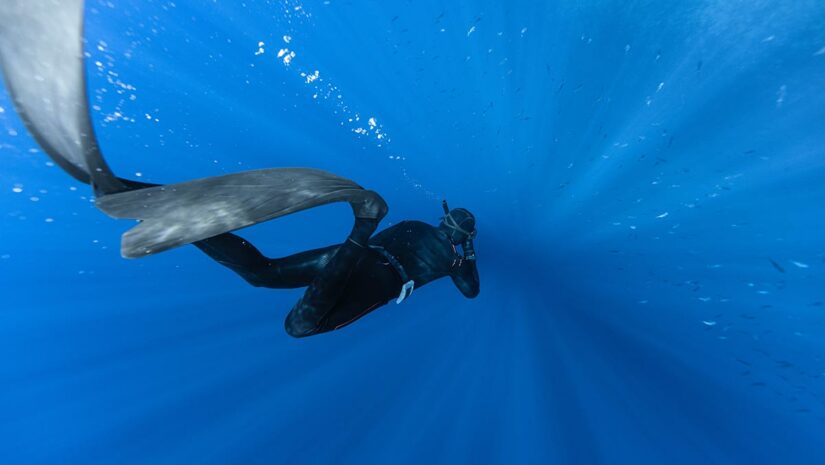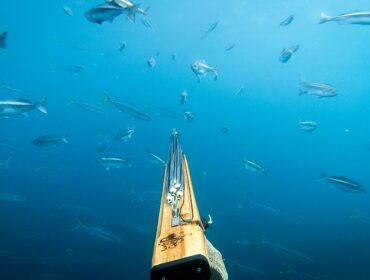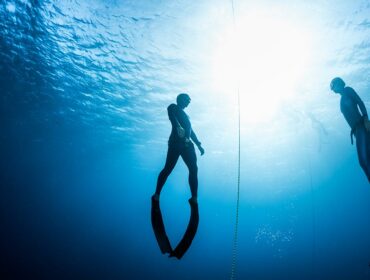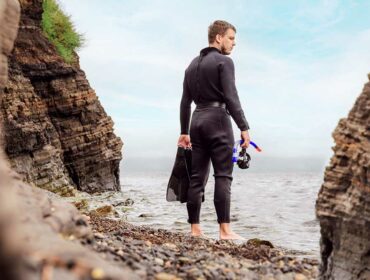Dive deep into the enchanting world of freediving — a sport and pastime that beckons adventurers to explore the ocean’s depths with nothing but a single breath. Unlike scuba diving, where the choice of diving equipment can determine the duration of your underwater exploration, freediving emphasizes the pure connection between the diver and the marine world. This profound connection, however, underscores the importance of having the right equipment.
Whether you’re a beginner or an experienced diver, selecting the best freediving fins for your underwater journey is paramount. As the propellers guiding you on your subaquatic voyage, no gear plays a more pivotal role than freediving fins. This guide is crafted to provide insights and direction for all diving enthusiasts in their quest to find the perfect pair of fins, striking a balance between comfort, performance, and safety.

The Anatomy of Freediving Fins
Freediving fins are distinct from other types of fins such as scuba, snorkeling, or swimming fins due to their unique design and purpose. The primary difference lies in their length and flexibility. Freediving fins are typically much longer and more flexible than scuba fins, which are shorter and stiffer to provide quick propulsion. This increased length aids divers in covering greater distances with fewer kicks and conserving precious energy making them ideal freediving fins for deep dives. Their sleek design facilitates smoother water flow, reducing drag and allowing divers to glide effortlessly, feeling almost bird-like underwater.
Snorkeling fins are even shorter for casual surface swimming, and swim fins are designed for training and improving leg strength and technique in a pool.
Parts of Freediving Fin
Foot Pocket
The foot pocket is where the diver’s foot enters and is held in place. It needs to be comfortable yet firm to efficiently transfer energy from the leg to the fin. Freediving foot pockets are designed to be worn with or without neoprene socks and can vary in rigidity. A softer foot pocket allows for a more comfortable experience during longer dives, while a stiffer one offers more direct power transfer.
Blade
The blade is the elongated part of the fin that propels the diver through the water. In freediving fins, the blade starts from the front of the foot pocket and extends to the tip of the fin. The blade’s length, width, and shape are critical factors in determining the fin’s performance. Longer blades provide more propulsion but require more energy, while shorter blades offer more maneuverability but less thrust.
Rails
Rails run along the edges of the blade and are often made of rubber or a similar material. They serve multiple functions: they help channel water down the length of the blade during a kick, provide stability, and prevent lateral movement which can waste energy and reduce efficiency.
Materials Used in Freediving Fins
The materials used in the construction of freediving fins are selected for their ability to provide the optimal balance between flexibility and resistance. Here are some common materials:
Plastic/Polypropylene
The most economical option, plastic fins are a good starting point for beginners. They are durable but generally less efficient in transferring energy compared to more advanced materials.
Fiberglass
Offering a good balance between flexibility and rigidity, fiberglass fins are a step up from plastic. They provide better performance and energy transfer, making them suitable for intermediate freedivers.
Carbon Fiber
The premium choice for serious and advanced freedivers, carbon fiber freediving fins are lightweight, highly responsive, and offer the best performance. They maximize energy transfer with each kick, allowing for longer and more efficient dives. However, they come at a higher cost and can be more fragile than plastic or fiberglass.
Each material offers different benefits and drawbacks, and the choice often comes down to a diver’s preference, budget, and the type of freediving they are engaging in. High-quality materials like carbon fiber are particularly favored in competitive freediving, where every fraction of a second and every meter of depth can make a significant difference.
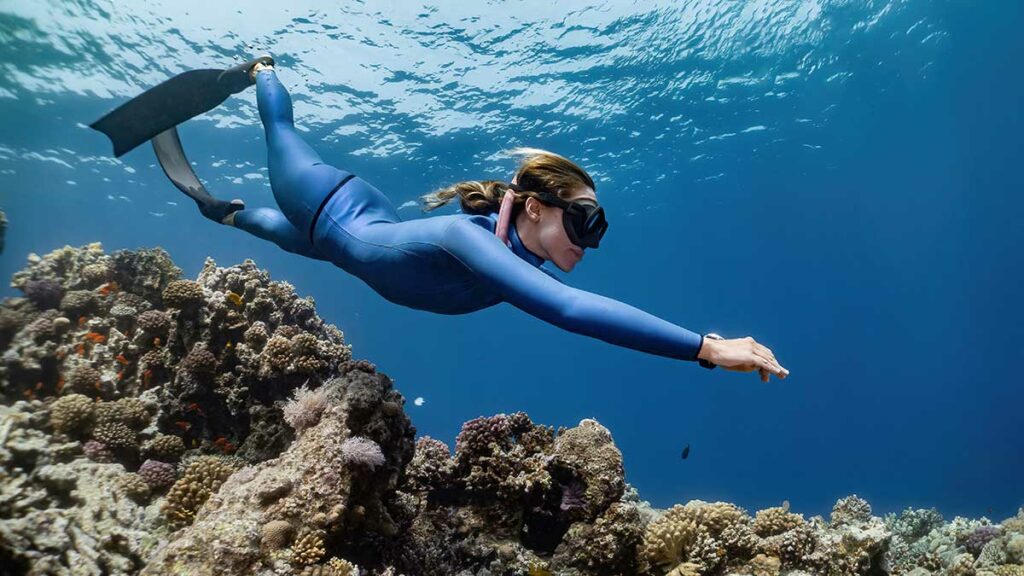
Types of Freediving Fins
Let’s explore the different types of freediving fins that divers can choose from based on their design and materials.
Full-foot Freediving Fins
- Overview: These fins are characterized by a closed heel, making them fit snugly around the foot.
- Advantages: They offer a streamlined profile and reduce drag. Being lightweight, they are also easier for long surface swims.
- Best for: Divers who are doing shore dives or those who prefer a more “natural” feel with their fins.
See below for some of our top full-foot freediving fins from brands including Cressi, Mares and Scubapro:
Open-heel Freediving Fins
- Overview: These fins come with an adjustable strap, allowing for a customized fit.
- Advantages: They can accommodate different footwear like dive boots, making them ideal for varying water temperatures and terrains.
- Best for: Divers venturing into colder waters or challenging terrains where foot protection is essential.
See below for some of our top open-heel freediving fins from brands including Cressi and Tusa:
Rigid Blade Freediving Fins
- Overview: Made from firm materials, these fins offer more resistance against the water and require stronger leg muscles and better technique to use effectively.
- Advantages: They provide powerful propulsion with each kick, making them ideal for deep dives and dives against strong currents.
- Best for: Experienced freedivers who dive to greater depths or those who need quick bursts of speed, such as spearfishers.
Flexible Blade Freediving Fins
- Overview: Made from softer materials, they are easier to kick with and more forgiving, making them suitable for newer divers with less developed leg muscles.
- Advantages: They offer a more natural and fluid kicking motion, making them great for longer durations and those who prefer a more relaxed dive.
- Best for: Beginners as they provide a smoother and more efficient energy transfer or those practicing for extended periods, as they reduce the chance of cramps and fatigue.
Carbon Fiber Freediving Fins
- Overview: These are high-end fins crafted from carbon fiber, known for their responsiveness and efficiency.
- Advantages: They are lightweight, offer maximum propulsion, and reduce diver fatigue.
- Best for: Professional and advanced divers willing to invest in top-tier gear.
See below for some of our top Full Wetsuits from brands including Mares:
Fiberglass Freediving Fins
- Overview: Made from fiberglass, these fins strike a balance between flexibility and rigidity.
- Advantages: They offer excellent performance without the premium price tag of carbon fiber.
- Best for: Intermediate divers or those transitioning from beginner gear.
Bi-fins (or Stereo fins) for Freediving
- Overview: These are the traditional pair of fins that most people are familiar with, one for each foot.
- Advantages: They offer a natural swimming motion and are available in various materials and stiffness levels.
- Best for: The majority of freedivers, from beginners to professionals, depending on the specific design and material.
Mono Fins for Freediving
- Overview: A single, wide fin that both feet fit into, making the diver’s legs move as one, much like a mermaid or dolphin.
- Advantages: It provides significant propulsion and is optimal for deep dives and competitive freediving.
- Best for: Experienced divers aiming for depth, and those participating in freediving competitions.
Unique Requirements of Freediving Fins
Freediving isn’t just about diving deep—it’s about doing so on a single breath, relying on one’s physical prowess and the efficiency of the gear. While other water sports, such as scuba diving, provide the luxury of extended underwater time courtesy of oxygen tanks, freediving is about maximizing depth and time with minimal assistance.
This makes the design and efficiency of freediving fins paramount. They are tailored to ensure divers can glide effortlessly and quickly, covering vast depths with minimal kicks. The reduced energy expenditure becomes crucial when every second counts, and every breath is held.
Freediving Fins vs. Spearfishing Fins:
While both freediving and spearfishing share certain similarities, the primary difference lies in the objectives of the diver. Freediving emphasizes depth and immersion in the marine world, while spearfishing is centered around the hunt.
- Length & Flexibility: Freediving fins are generally longer than spearfishing fins. This length is designed to offer maximum propulsion with fewer kicks, crucial for deep dives. On the other hand, spearfishing fins are often a tad shorter, providing agility to move around reefs and chase after fish.
- Stiffness: Freediving fins tend to have varied stiffness levels, with some experienced divers opting for stiffer fins to maximize propulsion. Spearfishing fins, meanwhile, lean towards a balance between stiffness and flexibility to provide both speed and agility.
- Material: While both types of fins can be found in materials ranging from plastic to carbon fiber, the choice often depends on the diver’s needs. Spearfishers might prefer the durability of fiberglass in rocky terrains, while a freedivers aiming for great depths might lean towards the responsiveness of carbon fiber.
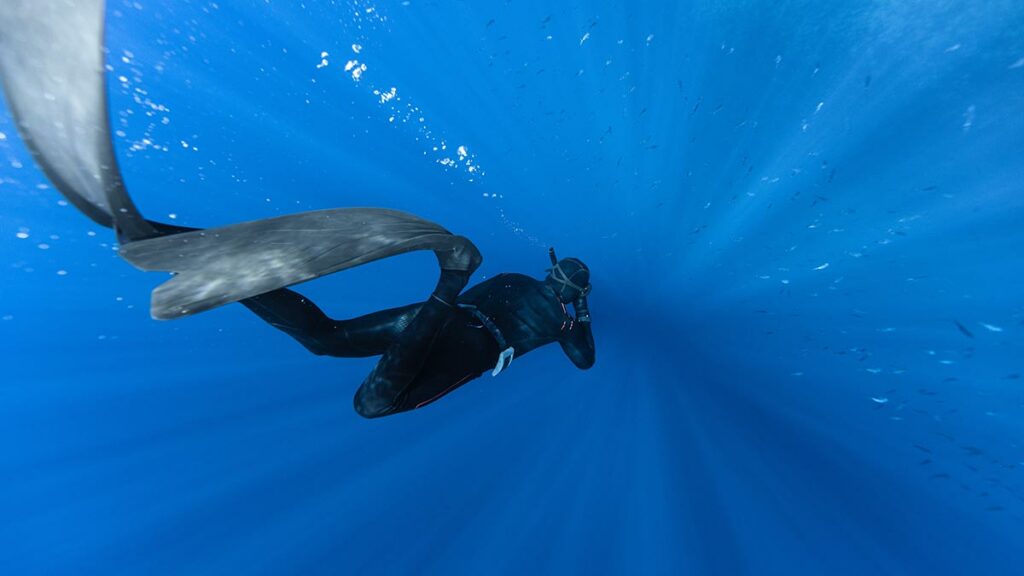
Importance of Fin Length in Freediving:
The Role of Length in Underwater Propulsion
Long Fins
These are the quintessential freediving fins, often extending well beyond the foot, sometimes up to 40 inches or more.
- Advantages: The added length increases surface area, translating to greater propulsion with each kick. It allows divers to achieve depth quickly and efficiently, conserving precious oxygen.
- Best for: Divers aiming for depth, those exploring deeper underwater sites, or participants in freediving competitions.
Shorter Fins
Less common in pure freediving, these are more akin to snorkeling fins, providing agility over depth.
- Advantages: Easier to maneuver, especially in tighter spaces or shallow waters. They’re also more portable, making them travel-friendly.
- Best for: Casual freedivers, those exploring shallower reefs, or divers transitioning from snorkeling to freediving.
The right fin length will ensure you’re not wasting energy with excessive kicks while also ensuring you’re moving efficiently through the water. After all, in freediving, every breath, every movement counts.
Maintaining and cleaning freediving fins:
Freediving Fins: Essential Care for Lasting Performance
Freediving fins are more than gear—they’re underwater allies. Maintaining them ensures dive after dive of seamless exploration.
Clean Regularly
- Rinse after each use to clear salt, sand, and debris.
- Use mild soap for tougher stains, avoiding harsh chemicals.
- Air dry in shade; direct sunlight can damage them.
Smart Storage
- Lay fins flat or hang vertically to prevent warping.
- Store in a cool, dry place away from sunlight.
- Consider fin bags for extra protection.
Know When to Repair or Replace
- Smooth out minor abrasions with fine sandpaper.
- Note changes in stiffness or overall performance.
- Cracks or inefficient propulsion signal it’s time for a new pair.
Conclusion
In the boundless embrace of the ocean, every decision you make shapes your freediving journey. The fins you choose aren’t just gear; they’re an extension of your ambitions, dreams, and commitment to the marine world. They define your dive, from the first ripple on the surface to the furthest depth you dare to explore.
Your fins dictate the rhythm of your journey, the efficiency of each kick, and the stories you’ll have to share when you resurface. Ensuring you have the perfect pair tailored to your needs is paramount. And remember, it’s not just about depth—it’s about experiencing the ocean in its purest form.
Ready to make waves? Dive into our curated collection of top-tier freediving gear on our website. Embrace the ocean with the best by your side.

